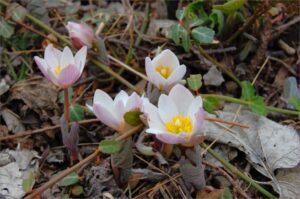Bruce Crawford, Manager of Horticulture for the Morris County Park Commission, has written another article for us. He uses Sanguinaria canadensis (common name, Bloodroot), to talk about early spring bulbs in general, but with a focus on this beautiful example.
Read the first paragraph, below, and click on the link below to open the full PDF.
The garden truly awakens during the month of April. The once bare earth suddenly comes alive with a bevy of flowering bulbs and perhaps even a few spring ephemerals. Most gardeners understand how to effectively work bulbs into a garden, but many remain puzzled over the use of spring ephemerals. By definition, this group of plants emerge in early spring, flower, set seed and enter into dormancy by the start of summer, very similar to most bulbs. Their strategy is to complete their annual life cycle before the tree canopy is fully leafed-out and competition for sunlight and water becomes more intense. Unlike most bulbs, this group of plants can be more challenging to work into the garden since the declining foliage can be more of a distraction to the beauty of the late spring garden. Fortunately, some ephemerals retain their foliage well into summer when there are ample floral distractions. Sanguinaria canadensis, commonly known as Bloodroot is just such a plant! A beautiful wildflower that erupts into color in March and April (as seen at right in early April in Northern NJ), it quietly enters into dormancy during the middle of summer.
